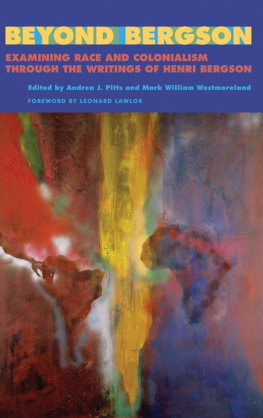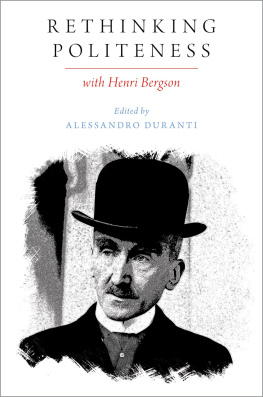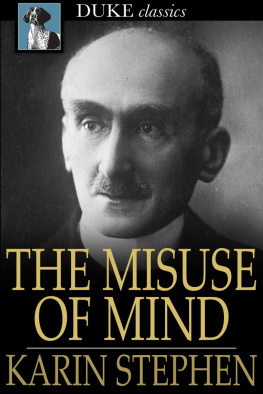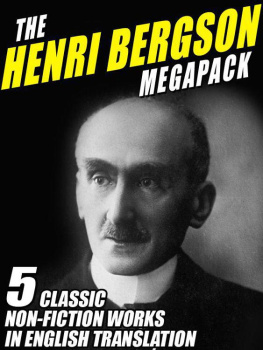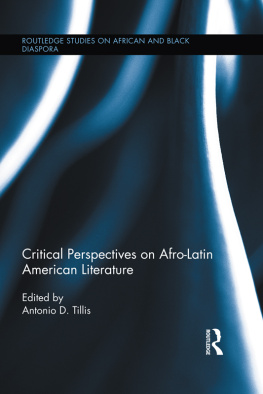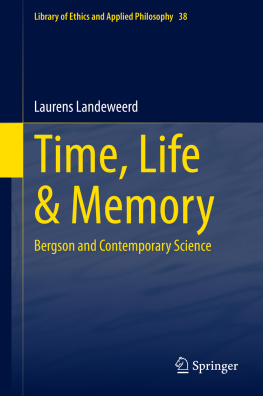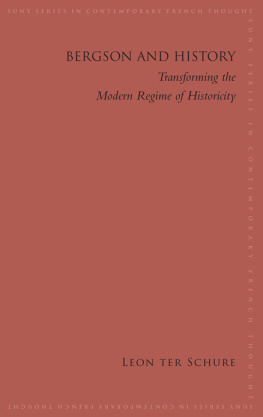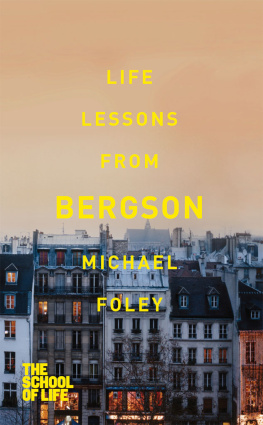BEYOND BERGSON
SUNY series, Philosophy and Race
Robert Bernasconi and T. Denean Sharpley-Whiting, editors
BEYOND BERGSON
EXAMINING RACE AND COLONIALISM
THROUGH THE WRITINGS OF HENRI BERGSON
EDITED BY
ANDREA J. PITTS AND
MARK WILLIAM WESTMORELAND
FOREWORD BY
LEONARD LAWLOR
On the cover: Night Journey by artist Frank Bowling (British, born Guyana, 1936)
Date: 196970
Medium: Acrylic on canvas
Dimensions: H. 833/4 W. 721/8 in. (212.7 183.2 cm)
Metropolitan Museum of Art, NY. Accession number 2011.590.2.
Gift of Maddy and Larry Mohr, 2011.
2018 Artists Rights Society (ARS), New York/DACS, London
Published by State University of New York Press, Albany
2019 State University of New York
All rights reserved
Printed in the United States of America
No part of this book may be used or reproduced in any manner whatsoever without written permission. No part of this book may be stored in a retrieval system or transmitted in any form or by any means including electronic, electrostatic, magnetic tape, mechanical, photocopying, recording, or otherwise without the prior permission in writing of the publisher.
For information, contact State University of New York Press, Albany, NY
www.sunypress.edu
Library of Congress Cataloging-in-Publication Data
Names: Pitts, Andrea J., editor. | Westmoreland, Mark William, 1983, editor.
Title: Beyond Bergson : examining race and colonialism through the writings of Henri Bergson / edited by Andrea J. Pitts and Mark William Westmoreland.
Description: Albany : State University of New York Press, [2019] | Series: SUNY series, philosophy and race | Includes bibliographical references and index.
Identifiers: LCCN 2018020075 | ISBN 9781438473512 (hardcover : alk. paper) | ISBN 9781438473536 (ebook)
Subjects: LCSH: Bergson, Henri, 18591941.
Classification: LCC B2430.B43 B479 2019 | DDC 194dc23
LC record available at https://lccn.loc.gov/2018020075
10 9 8 7 6 5 4 3 2 1
Contents
Leonard Lawlor
Introduction
Creative Extensions
Andrea J. Pitts and Mark William Westmoreland
Part I
Bergson on Colonialism, Social Groups, and the State
Chapter 1
Decolonizing Bergson: The Temporal Schema of the Open and the Closed
Alia Al-Saji
Chapter 2
The Language of Closure: Homogeneity, Exclusion, and the State
Martin Shuster
Chapter 3
The Politics of Sympathy in Bergsons The Two Sources of Morality and Religion
Melanie White
Part II
Bergsonian Themes in the Ngritude Movement
Chapter 4
Bergson, Senghor, and the Philosophical Foundations of Ngritude: Intellect, Intuition, and Knowledge
Clevis Headley
Chapter 5
The Spectacle of Belonging: Henri Bergsons Comic Negro and
the (Im)possibility of Place in the Colonial Metropolis
Annette K. Joseph-Gabriel
Part III
Race, Revolution, and Bergsonism in Latin America
Chapter 6
Racial Becomings: Evolution, Materialism, and Bergson in Spanish America
Adriana Novoa
Chapter 7
Bergsonism in Postrevolutionary Mexico: Antonio Casos Theory of Aesthetic Intuition
Andrea J. Pitts
Chapter 8
Antagonism and Myth: Jos Carlos Mariteguis Revolutionary Bergsonism
Jaime Hanneken
Foreword
The Hope for this Volume: Sympathy
L EONARD L AWLOR
It is an honor for me to write the foreword to this volume, which extends Henri Bergsons thought into areas of research that Bergson himself probably would have never imagined. It is in fact gratifying for me to see a volume like this appear. It is a good sign for those of us who see in Bergson a model for philosophical work. Over the twenty years or so that I have worked on Bergson, three ideas have appeared to me to be fundamental in his thinking and fundamental for genuine philosophical work: the starting point in an intuition, the idea of qualitative multiplicity, and the idea of creative emotions. This last idea comes from Bergsons The Two Sources of Morality and Religion. The Two Sources, appearing in 1932, may be Bergsons greatest work. It is also, however, the most controversial. I will turn to what is controversial in The Two Sources at the end of this foreword. The problem of what Bergson says about the primitives in The Two Sources will disclose my hope for this volume.
The first idea that is fundamental is the starting point for all philosophical thinking in an intuition. In Bergson, the word intuition has two senses. On the one hand, for Bergson, intuition refers to a method. It is precisely the expression of the experience in meaningful words and actions that distinguishes the mystic from the madman. I think the identification of intuition with a mystical vision is important because it seems that philosophy must maintain its traditional aim of being presuppositionless. If philosophy indeed aims to be presuppositionless, then only an encounter like the mystical vision allows us to eliminate presuppositions. As philosophers, we need to be thrown into disequilibrium. But is this encounter enough to free us from the prejudices relative to our times? As we shall see at the end, the answer is probably not.
The second idea that is fundamental for philosophical thinking in general is Bergsons idea of qualitative multiplicity. In his first book, Time and Free Will, published in 1889, Bergson distinguishes (through the method of intuition) qualitative multiplicity from quantitative multiplicity. As the name suggests, a quantitative multiplicity enumerates things or states of consciousness by means of externalizing one from another in a homogeneous space. In contrast, a qualitative multiplicity consists in a temporal heterogeneity, in which several conscious states are organized into for a new kind of social collectivity, one that is at once heterogeneous and interpenetrating, or, more simply, one that is sympathetic.
The third idea that is fundamental for philosophical thinking in general is the idea of creative emotions. Creative emotions elaborate on the idea of intuition with which we started, and therefore we turn back to The Two Sources. The difference between creative emotions and normal, uncreative emotions consists in this: in normal emotions, we first have a representation that causes the feeling (I see my friend and then I feel happy); in creative emotion, we first have the emotion that then creates representations. Outside of all the intellectual work of selecting and arranging, the composer was in search of inspiration, an indivisible emotion which intelligence helped to unfold into music. Thanks to the two examples, we see that creative emotions are themselves created (Rousseau), but also creating (Beethoven). The idea of creative emotions is important for philosophical thinking because a creative emotion, like an intuition and a mystical vision, throws one out of the habitual mode of thinking. It requires the abandonment of common sense and customs. Within The Two Sources, creative emotions are important because they open an individuals soul, transforming the person into a hero, who in turn opens society through the creation of new values, and the hero being a mystic makes religion dynamic. Dynamic religion is the religion of love. In The Two Sources

